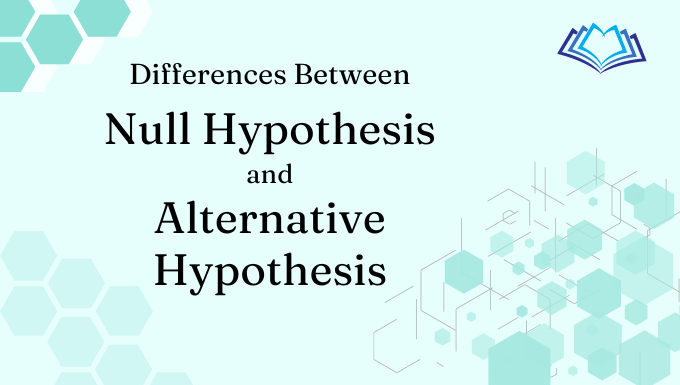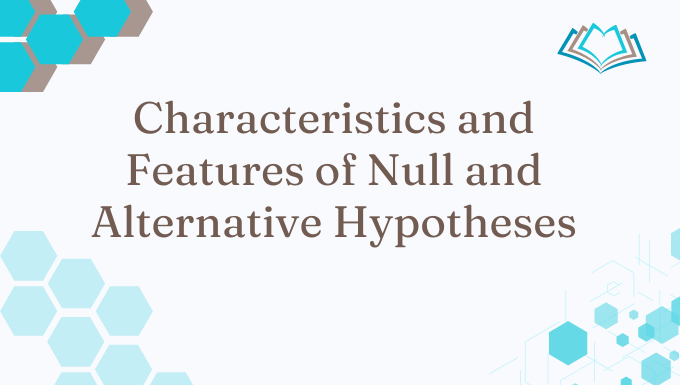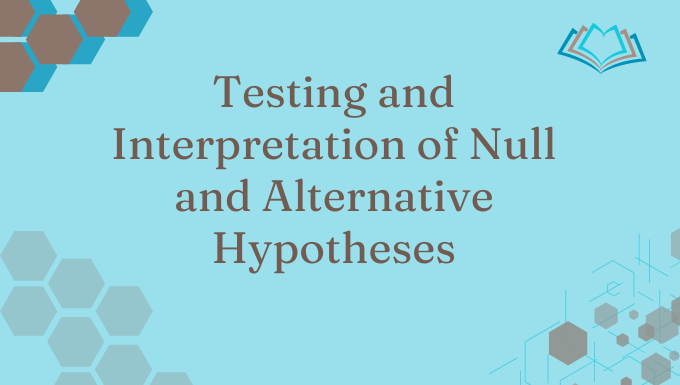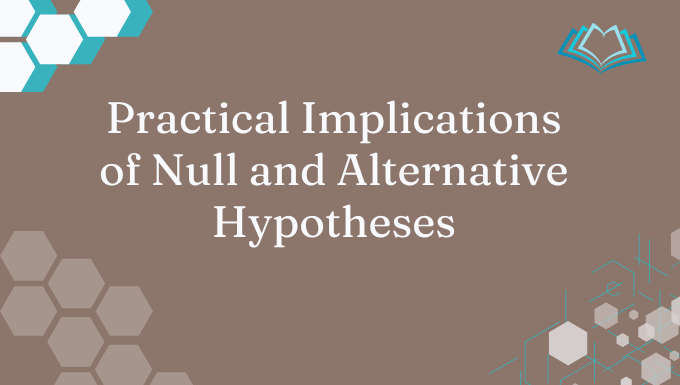Table of Contents

Introduction
Hypothesis testing is a core component of research, involving the formulation and testing of two competing hypotheses: the null hypothesis, suggesting no effect, and the alternative (or first) hypothesis, proposing a specific effect. Through statistical analysis of sample data, researchers evaluate whether to reject the null (or zero) hypothesis, drawing conclusions about their research questions based on the evidence gathered.
The null and alternative hypothesis are fundamental concepts in hypothesis testing, a key component of both qualitative and quantitative research methodologies.
Importance of Understanding the Differences between Null and Alternative Hypotheses
Understanding the differences between null and alternative hypotheses is crucial in research methodology as it forms the basis for hypothesis testing. Recognizing these distinctions enables researchers to formulate clear research questions, design appropriate experiments, and interpret statistical results accurately. It helps researchers to articulate precisely what they aim to investigate, ensuring that their findings are meaningful, valid, and interpretable within the context of their study.
Additionally, a clear understanding of these hypotheses aids in making informed decisions about research methodologies, sample sizes, and data analysis techniques, thereby contributing to the rigor and reliability of the research process.
I. Definition and Purpose
The null hypothesis suggests no effect, attributing observed differences to chance, while the alternative hypothesis proposes a specific effect between variables. Understanding these hypotheses is crucial for guiding research design and interpretation.
Definition of Null Hypothesis
The null (or zero) hypothesis posits no effect or relationship between variables, serving as a baseline for statistical analysis. It suggests that observed differences are due to chance and provides a comparison point for evaluating the alternative hypothesis.
Purpose of Null Hypothesis in Hypothesis Testing
The purpose of the null (or zero) hypothesis in hypothesis testing is to serve as a baseline assumption of no effect or relationship between variables. It provides a reference point for evaluating the significance of observed results and comparing them to the alternative (or first) hypothesis.
Definition of Alternative Hypothesis
The alternative hypothesis proposes a specific effect or relationship between variables, contrasting the null hypothesis. It represents the researcher’s hypothesis of interest and is evaluated against the null (or zero) hypothesis to determine the significance of observed results.
Role of Alternative Hypothesis in Hypothesis Testing
The role of the alternative hypothesis in hypothesis testing is to propose a specific effect or relationship between variables. It contrasts the null hypothesis and serves as the researcher’s primary hypothesis of interest, guiding the evaluation of observed results for significance.
II. Characteristics and Features of Null and Alternative Hypotheses

The null hypothesis posits no effect or relationship between variables, serving as a baseline for analysis. In contrast, the alternative hypothesis proposes a specific relationship and represents the researcher’s primary interest. Understanding these features guides research design and interpretation.
Characteristics and Features of Null Hypotheses
The characteristics and features of null hypotheses include:
- No Effect or Relationship: It posits that there is no effect or relationship between the variables being studied.
- Baseline Assumption: It serves as a starting point for statistical analysis, suggesting that any observed differences are due to chance.
- Testable Statement: It is formulated in a way that it can be tested using empirical data through statistical methods.
- Comparison Point: It provides a reference point against which the alternative (or first) hypothesis is evaluated to determine the significance of observed results.
- Simple and Clear: Null hypotheses are typically stated in clear and straightforward terms, making them easy to understand and test.
Understanding these characteristics helps researchers design experiments, select appropriate statistical tests, and interpret results accurately in hypothesis testing.
Characteristics and Features of Alternative Hypotheses
The characteristics and features of alternative hypotheses (H1) include:
- Specific Relationship: It proposes a specific effect or relationship between the variables being studied, contrasting the null hypothesis.
- Primary Interest: It represents the researcher’s primary hypothesis of interest and is the focus of the hypothesis testing process.
- Testable Statement: It is formulated in a way that it can be tested using empirical data through statistical methods.
- Contrast with Null Hypothesis: It directly contrasts the null (or zero) hypothesis, providing a clear alternative explanation or prediction for the observed phenomena.
- Guides Analysis: It guides the selection of statistical tests and the interpretation of results, determining whether to reject the null hypothesis in favor of the alternative based on the evidence gathered.
Understanding these characteristics helps researchers articulate clear research questions, design appropriate experiments, and interpret results effectively in hypothesis testing.
III. Formulation and Representation of Null and Alternative Hypotheses

Formulating and representing the alternative hypothesis is crucial for hypothesis testing. It proposes a specific effect or relationship between variables, serving as the researcher’s primary focus. A clear and precise formulation guides research design and ensures the hypothesis is testable with suitable statistical methods, contrasting the null hypothesis effectively.
Examples of Null Hypotheses in Different Research Contexts
- Medical Research:
- There is no difference in blood pressure levels between patients who received the treatment and those who received a placebo.
- Educational Research:
- There is no difference in test scores between students who used the new learning method and those who used traditional methods.
- Environmental Science:
- There is no difference in plant growth rates between plants exposed to sunlight and those kept in the shade.
- Social Sciences:
- There is no association between socioeconomic status and mental health outcomes.
- Business Research:
- There is no difference in customer satisfaction ratings between online and in-store shopping experiences.
These examples illustrate how null hypotheses are formulated to state no effect or difference between groups or conditions, providing a basis for hypothesis testing in various research contexts.
Examples Illustrating Various Forms and Expressions of Alternative Hypotheses
- Medical Research:
- Patients who received the treatment will have lower blood pressure levels compared to those who received a placebo.
- Educational Research:
- H1: Students who used the new learning method will achieve higher test scores than those who used traditional methods.
- Environmental Science:
- Plants exposed to sunlight will show faster growth rates compared to those kept in the shade.
- Social Sciences:
- There is a positive association between higher socioeconomic status and improved mental health outcomes.
- Business Research:
- Customers will report higher satisfaction ratings with online shopping compared to in-store experiences.
These examples demonstrate the various forms and expressions of alternative hypotheses, which propose specific effects or relationships between variables in different research contexts.
IV. Testing and Interpretation of Null and Alternative Hypotheses

Testing and interpreting null and alternative hypotheses are crucial steps in research. Statistical methods evaluate the significance of observed results against the null hypothesis, while the alternative hypothesis offers a specific prediction. Interpreting these results informs conclusions about variable relationships and guides further research.
Testing Procedures and Criteria for Accepting or Rejecting the Null Hypothesis
The testing procedures for the null (or zero) hypothesis involve selecting an appropriate statistical test based on the research design and data characteristics. The chosen test calculates a p-value, which indicates the probability of obtaining the observed results or more extreme results if the null (or zero) hypothesis were true.
Criteria for Accepting or Rejecting the Null Hypothesis:
- Significance Level (α): Typically set at 0.05, the significance level determines the threshold for rejecting the null hypothesis. If the calculated p-value is less than α, the null (or zero) hypothesis is rejected.
- P-value: A p-value less than the significance level (α) indicates that the observed results are statistically significant, providing evidence against the null hypothesis.
- Comparison with Critical Value: In some cases, statistical tests use critical values instead of p-values. If the test statistic exceeds the critical value, the null (or zero) hypothesis is rejected.
- Confidence Intervals: Confidence intervals can also be used to assess the null (or zero) hypothesis. If the interval includes the null value (often zero), the null (or zero) hypothesis may not be rejected.
By applying these testing procedures and criteria, researchers can make informed decisions about accepting or rejecting the null hypothesis, thereby drawing conclusions about the relationships between variables based on empirical evidence.
Type I and Type II Errors in Null Hypothesis Testing
In hypothesis testing, errors can occur that affect the decision to reject or fail to reject the null hypothesis. These errors are classified into two types: Type I and Type II errors.
Type I Error (False Positive)
- Definition: Occurs when the null hypothesis is incorrectly rejected, indicating a significant effect or relationship when none actually exists.
- Probability: Denoted by α (alpha), the significance level, which sets the probability of committing a Type I error.
- Consequence: Researchers may mistakenly conclude that there is an effect or relationship between variables when there isn’t, leading to incorrect interpretations and conclusions.
Type II Error (False Negative)
- Definition: Occurs when the null hypothesis is incorrectly not rejected, failing to detect a significant effect or relationship that actually exists.
- Probability: Denoted by β (beta), the probability of committing a Type II error depends on factors like sample size, effect size, and significance level.
- Consequence: Researchers may overlook genuine effects or relationships between variables, potentially missing out on important findings and insights.
Understanding and minimizing the risks of Type I and Type II errors are essential for maintaining the integrity of hypothesis testing and ensuring accurate interpretations of research findings.
Alternative Hypothesis
Importance of Specifying Directionality (One-Tailed vs. Two-Tailed Tests)
When formulating the alternative hypothesis (H1), specifying directionality is crucial as it determines the type of statistical test and the interpretation of the results. This specification distinguishes between one-tailed and two-tailed tests, each serving different research objectives.
One-Tailed Test
- Definition: Focuses on a specific direction of the effect or relationship proposed in the alternative (or first) hypothesis.
- Example: H1: The new medication will decrease blood pressure compared to the control group.
- Importance:
- Increased Sensitivity: One-tailed tests can be more sensitive to detecting effects in a specific direction.
- Hypothesis Specificity: Provides a clear and precise prediction, narrowing the scope of the research question.
- Efficiency: Can require fewer resources compared to two-tailed tests when examining a specific hypothesis.
Two-Tailed Test
- Definition: Considers the possibility of the effect or relationship in both directions (positive and negative) relative to the null hypothesis.
- Example: H1: There is a difference in blood pressure between the groups.
- Importance:
- Comprehensive Analysis: Provides a broader view of the potential effects, capturing both increases and decreases in the dependent variable.
- Flexibility: Allows for unexpected findings in either direction without needing to modify the hypothesis.
- Generalizability: Results can be generalized more broadly when not confined to a specific direction.
Choosing between one-tailed and two-tailed tests should align with the research question’s objectives and the hypothesis’s specific predictions. Clear directionality specification ensures appropriate test selection, accurate interpretation of results, and meaningful conclusions in hypothesis testing.
Criteria for Supporting the Alternative Hypothesis
Support for the alternative hypothesis is assessed based on:
- Statistical Significance:
- Achieved with a p-value less than α (typically 0.05) or confidence intervals excluding zero.
- Effect Size:
- A larger effect size indicates a stronger relationship or effect.
- Practical Significance:
- Real-world relevance beyond statistical findings.
- Consistency:
- Replicable findings across studies strengthen support.
- Theoretical Support:
- Alignment with existing theories or prior research.
- Robustness:
- Consistent results across different analyses or methodologies.
These criteria ensure rigorous evaluation of the alternative hypothesis, supporting meaningful and reliable conclusions.
V. Practical Implications of Null and Alternative Hypotheses

The practical implications of null and alternative hypotheses go beyond statistical findings, influencing decision-making and applications in various fields. Understanding these implications guides informed choices, interventions, and advancements in both academic and real-world contexts.
Accepting the Null Hypothesis and Its Implications
When the null hypothesis (H0) is accepted, it suggests that there is no significant effect or relationship between the variables being studied, based on the available evidence and statistical tests. Accepting the null (or zero) hypothesis has several implications:
- No Action Required:
- In practical terms, accepting the null hypothesis may suggest that there is no need for intervention or change based on the current findings.
- Status Quo Maintained:
- The existing conditions or practices can continue without alteration, assuming the absence of a significant effect.
- Resource Allocation:
- Resources may be allocated to other areas or research questions where a significant effect or relationship is detected, optimizing resource utilization.
- Limitations Acknowledged:
- Accepting the null hypothesis acknowledges the limitations of the study and may lead to further exploration to understand the factors contributing to the non-significant results.
- Validation of Methods:
- The acceptance of the null hypothesis validates the research methods used, indicating that the study’s design and execution were appropriate for the research question.
Understanding and accepting the null (or zero) hypothesis provide valuable insights into the absence of expected relationships or effects, guiding subsequent research directions, and informing decision-making processes.
Supporting the Alternative Hypothesis and Its Significance
Supporting the alternative hypothesis (H1) indicates that there is a significant effect or relationship between the variables under investigation, based on the evidence and statistical tests conducted. Here are the significance and implications of supporting the alternative hypothesis:
- Actionable Insights:
- Supporting the alternative (or first) hypothesis provides actionable insights, suggesting that interventions or changes may be beneficial based on the observed effects or relationships.
- Informed Decision-Making:
- Decision-makers can use the findings to make informed choices, implement effective strategies, and address the identified issues or opportunities.
- Validation of Hypothesis:
- The support for the alternative hypothesis validates the research hypothesis, indicating that the proposed relationship or effect between variables is statistically and practically significant.
- Advancement of Knowledge:
- The findings contribute to the existing body of knowledge, offering new perspectives, theories, or explanations that can guide future research and understanding in the field.
- Resource Allocation:
- Resources can be allocated to implement and evaluate the proposed interventions or strategies, maximizing their potential impact based on the supported findings.
Supporting the alternative hypothesis underscores the importance of the observed effects or relationships, emphasizing their relevance and significance in influencing outcomes, practices, and understanding within the research context.
Potential impact on Theory, Practice, and Policy
Supporting the alternative hypothesis can have far-reaching implications across theory, practice, and policy:
Impact on Theory:
- Theory Advancement:
- Supporting the alternative hypothesis can lead to the advancement of existing theories by providing empirical evidence that refines or extends theoretical frameworks.
- Paradigm Shifts:
- Strong evidence in favor of the alternative (or first) hypothesis may challenge prevailing theories, leading to paradigm shifts and the emergence of new theoretical perspectives.
Impact on Practice:
- Evidence-Based Interventions:
- Empirical support for the alternative hypothesis guides the development and implementation of evidence-based interventions, enhancing their effectiveness and relevance.
- Professional Standards:
- Supported findings can influence professional standards, guidelines, and practices, ensuring alignment with current research evidence and fostering excellence in professional fields.
Impact on Policy:
- Informed Policy Development:
- Policymakers can use the supported findings to inform the development and revision of policies, regulations, and initiatives, ensuring they are grounded in robust evidence and targeted towards addressing identified issues.
- Advocacy and Reform:
- Advocacy efforts can leverage research findings to advocate for policy changes, reforms, and investments in areas where the alternative hypothesis suggests significant effects or relationships, driving systemic improvements and societal change.
Supporting the alternative hypothesis holds the potential to significantly influence and advance theory, inform evidence-based practices, and shape impactful policies, contributing to positive changes and advancements across various disciplines and sectors.
Conclusion: Differences Between Null and Alternative Hypothesis
The null and alternative hypothesis serve distinct roles in hypothesis testing, each with unique characteristics and implications:
- Null Hypothesis:
- Definition: Assumes no effect or relationship between variables.
- Purpose: Serves as the baseline for statistical analysis and comparison with the alternative (or first) hypothesis.
- Acceptance: Accepting the null (or zero) hypothesis suggests no significant effect, maintaining the status quo.
- Criteria: Evaluated based on statistical significance, often with a focus on disproving it.
- Alternative Hypothesis:
- Definition: Proposes a specific effect or relationship between variables.
- Purpose: Represents the researcher’s primary hypothesis of interest, guiding the research focus and interpretation of results.
- Support: Supporting the alternative (or first) hypothesis provides evidence for a significant effect or relationship, driving further inquiry and applications.
- Criteria: Evaluated based on statistical significance, effect size, practical significance, and alignment with existing theories or prior research.
Understanding these differences is essential for formulating clear research questions, designing appropriate experiments, conducting rigorous analyses, and interpreting findings accurately. By distinguishing between the null and alternative hypotheses, researchers can make informed decisions, advance knowledge, and contribute meaningfully to their respective fields.